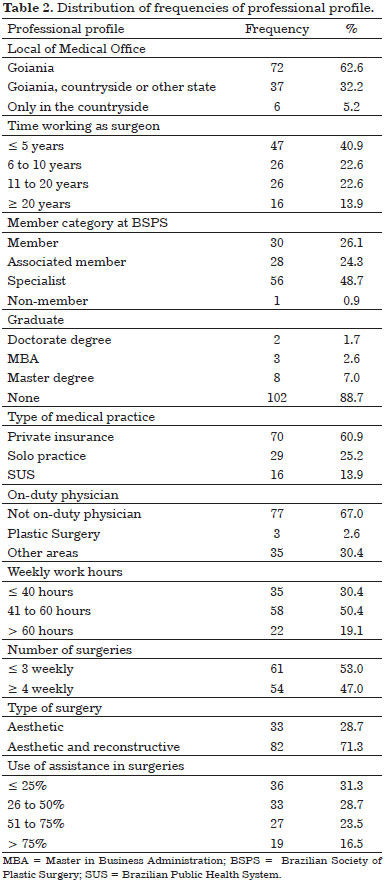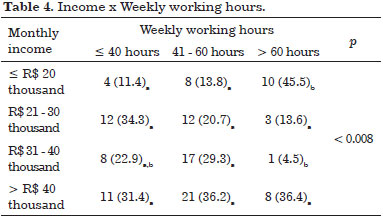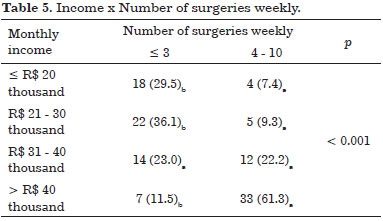

Original Article - Year 2016 - Volume 31 -
Profile of plastic surgeons in the state of Goias, Brazil
Perfil do cirurgião plástico no Estado de Goiás, Brasil
ABSTRACT
INTRODUCTION: Plastic surgery has become popular in the recent years for the access to procedures and exposure in the media. The current scenario brings difficulties in the job market because of competitiveness and reduced fees. This study describes the profile of the plastic surgeons working in the state of Goias.
METHODS: The survey was conducted with plastic surgeons who work in the state of Goias and are registered in local chapter of the Brazilian Society of Plastic Surgery in January 2015. Data were divided into socio-economic and demographic profile. Inclusion criteria were residence certified by the Brazilian Ministry of Education or by the Brazilian Society of Plastic Surgery,, practice of plastic surgery in the state of Goias. We excluded residents in plastic surgery, and those who not practice in plastic surgery area.
RESULTS: Rate of response was 70%. Most participants were younger than 40 years old, men, married, with 1-2 children, work in Goias, had less than 10 years as a surgeion, had specialization in plastic surgery, work 40-60 hours weekly and main practice was in aesthetic and reconstructive area, the majority of them do not employ assistances in more than 50% of surgeries.
CONCLUSION: The profile of plastic surgeon in state of Goias is composed by young physicians, men, married, with no more than 2 children, and whom practice mainly in the state capital, most of them are specialists, work 40-60 hours per week, and their main practice is with aesthetic and reconstructive surgery.
Keywords: Surgery, plastic; Job market; Economics, medical; Brazil.
RESUMO
INTRODUÇÃO: A Cirurgia Plástica tem sido popularizada nos últimos anos, por meio do acesso aos procedimentos e exposição nos meios de comunicação. O contexto atual relata dificuldades no mercado de trabalho devido à competividade e diminuição de honorários. O objetivo deste estudo é relatar o perfil do cirurgião plástico que atua no Estado de Goiás.
MÉTODOS: A pesquisa foi realizada com cirurgiões plásticos que atuam no estado de Goiás registrados na regional da Sociedade Brasileira de Cirurgia Plástica (SBCP) até janeiro de 2015. Os dados foram divididos em perfil socioeconômico e demográfico. Foram considerados como critérios de inclusão residência pelo Ministério da Educação ou pela SBCP e estar atuando em Cirurgia Plástica no estado de Goiás. Como critérios de exclusão ser médico residente em cirurgia plástica e não estar atuando na área de Cirurgia Plástica.
RESULTADOS: Obteve-se o índice de resposta de 70%. A maioria tem menos de 40 anos, masculino, casado, com 1 a 2 filhos, atuando em Goiás, há menos de 10 anos, são especialistas, trabalhando de 40 a 60 horas semanais e atuam na área estética e reconstrutiva e a maioria não usa auxiliar em mais de 50% das cirurgias realizadas.
CONCLUSÃO: O perfil do cirurgião plástico do estado de Goiás é o de um médico jovem, do sexo masculino, casado, com até 2 filhos, que atua principalmente na capital, sendo a maioria especialista, que trabalha de 40 a 60 horas semanais, e atuando na cirurgia estética e reconstrutiva.
Palavras-chave: Cirurgia plástica; Mercado de trabalho; Economia médica; Brasil.
Plastic surgery has become popular in the recent years because of the ease access to procedures and exposure in the media1.
The diffusion of knowledge by residency programs in plastic surgery allowed that after training, plastic surgeons can practice in regions that was previously had few professionals, however, metropolitan areas2,3 continue to be preferred location, either because there are better infrastructure and because these areas have more people looking for plastic surgery.
For this reason, early career surgeons and more experienced surgeons have reported increase in the difficulty to enter in the labor market due to decreased fees2,4,5, lack of options to work in public hospitals and higher demand from patients6,7.
OBJECTIVE
This study reports profile of the plastic surgeon who practice in the state of Goias, Brazil.
METHODS
A survey was conducted using a socioeconomic form with data related to professional activities that was developed specifically for the data collection. The questionnarie included 17 multiple-choice questions. This study was approved by Ethics and Research Committee, and registered in Platform Brazil, CAAE number 37151714.9.000.5078. This paper is based on the final paper of a master degree in health sciences of the Federal University of Gois.
Variables evaluated were: age, marital status, type of graduate program, sex, local of practice of the plastic surgeon, number of children, time as a surgeon, medical office location, membership of Brazilian Society of Plastic Surgery (BSPS), membership category at BSPS, type of medical practice, on-duty shifts, weekly working hours, number of surgeries weekly, type of surgery, employment of an assistant , and monthly income. Data were divided into demographic and professional profile.
Initially, data were collected online using a standard form of Google forms among members of local chapter of BSPS in Goiás registered up to January 2015. The form was sent by e-mail with response deadline of 30 days. In last day of deadline we called participants by phone to confirm if they have responded the questionnaire. After this first approach, more data were collected at regional courses, at physicians' office or in hospitals in which the surgeon worked.
Inclusion criteria were residence certified by the Ministry of Education or by the Brazilian Society of Plastic Surgery, practice as in plastic surgery in the state of Goias. We excluded residents in plastic surgery, and those who did not practice in plastic surgery area. All participants signed the consent form, and confidentiality of information was guaranteed.
RESULTS
The method of sending emails, contact over the phone, and personal approach collected 115 responses of 163 questionaries initially sent. Of participants, 59.5% were younger than 40 years. Most of participants were man, married, with 1-2 children, working in state of Goias and their gross salary was over R$30,000.00 (Table 1).

The main location of medical office was in Goiania, most of them worked for less than 10 years as surgeons, were specialists certified by the BSPS, did not have graduate degree, worked primarily with health insurance plans and on private basis, worked 40-60 hours per week, and performed less than 3 surgeries weekly, did work in on-duty shifts, practice in aesthetic and reconstructive surgery area, and more than 50% of them did not employ an assistant in surgeries (Table 2).

We also compared data related with monthly income with time working as a plastic surgeon (Table 3), weekly working hours (Table 4) and number of surgeries per week (Table 5).



DISCUSSION
Studies related to plastic surgery, economy and labor market8,9 are common especially in the United States and Canada. Brazil has few studies comparing this relationship.
In 2009, a study conducted by BSPS reported only 10% of response in survey that addressed overall situation of plastic surgeons in our country. In 2010, IBOPE (Instituto Brasileiro de Opinião Pública e Estatística-in Portuguese; Brazilian Institute of Public Opinion and Statistics) investigated plastic surgery market with a response rate of 8%3. In 2013, Araújo et al.2 published a study in State of Parana with 40.5% of responses. Our study was obtained 70% responses of the plastic surgeon population in the State of Goias. We believe that the initial work with a sample calculation previously established as the study objetive, the study previous designed to obtain data enabled the achievement of a representative participation of plastic surgeons in the state of Goias.
Most of this study population was composed by young plastic surgeons, man, specialists members of BSPS and who worked for less than 10 years as a surgeon. Our findings differed from those reported by Araújo et al.2 and IBOPE (Datafolha) in which sample was composed by surgeons who worked for more years as plastic surgeons. Because most participants were man, this datum clearly suggest the difficult of women to balance of private life and act as surgeons, which normally involves many hours in surgery.
In Datafolha study answers were given by experts were 65%, Paraná 68% and our study 48.7%. Surgeons from Parana carried out 35% of surgeries in SUS, and in our study 14% of surgeons perfomed surgires in public health system.
A study published by Krieger and Lee10 in 2004 highlights a change in area of actuation of American plastic surgeons who now give priority to aesthetic surgeries compared with reconstructive surgeries because of reduction of the fees paid by the insurances companies10-13. The same change is clearly seen in our country that very low fees are offered by insurances companies and low wages paid by SUS. These facts end up influencing plastic surgeon's decision to finish residence and pursue a career in aesthetic surgery14,15. In our study, about 30% of participants worked only with aesthetic surgery and the remaining worked with aesthetic and reconstructive surgery.
Paraná study reported that most surgeons had 10-20 years of experience. In our study, most surgeons had less than 10 years of experience. In Datafolha data 68% surgeons had less than 15 years of experience. Therefore, these data show that many young surgeons are entering in the specialty, and this clarifies the worsening of the market in terms of competitive and price.
Economic stabilization in the beginning of this century led to an increase of demand for aesthetic surgery that is associated with increase of plastic surgeons entering in the market, therefore justifying the competitiveness and reduction in fees12, commodification of labor and the invasion of insurance companies. Paraná study evaluated characteristics of the market and payment methods of local surgeons. Our study did not include this aspect.
In our study most surgeons worked 40 to 60 hours weekly, performed up to 10 surgeries a week, both aesthetic and reconstructive surgeries. A similar result was observed by Araujo et al.2 study in which an significant part of surgeons performed 10-20 surgeries/monthly followed by those who performed 20-30 surgeries/monthly. Datafolha pool reported average of three cosmetic surgeries a week, therefore, data found are similar to those found in the national literature.
Other studies5,7,10,11,16-18 report that after 20 years of graduation, the number of surgeries performed monthly decrease because at this stage of the career the surgeon reduces number of surgeries for personal reasons or career circumstances. In our study we did not observe reduction of number of surgeries even after 20-year career.
When monthly income was compared with other variables we seen that after 10 years of professional experience, professionals monthly income improve and there is an increase in the number of surgeries, showing that as time goes by results of the work appear. No significant result was seen in relation to monthly income and weekly working hours. This can be justified because early career surgeon often need to work on-duty shifts and after many years of practice, an increased is seen in number of clients, surgeries and weekly working hours.
Of the sample, only 40% employed an assistant in more than 50% of surgeries. In Parana 52.8% of surgeons did not employ an assistant in surgeries, Except in cases in which of minor surgery and liposuction, larger surgeries should have the presence of another colleague in order to increase patient safety and allow early career physician to gain experience about the market, also learn techniques, as well pricing ethical and prevent these new professionals to put energy on-duty shifts at different areas than plastic surgery.
We observed that 30% of plastic surgeons work as on-duty physicians in other areas of medicine. This finding is a concern because shows that early career surgeons are having trouble to be successfully absorbed by the market, which force them to perform as on-duty to guarantee their family income. Experience surgeons should encourage participation of assistant surgeons to help early career surgeon to not waste energy in on-duty shifts in other areas. Such action would help to reduce surgical time, reduce time for anesthesia, and also lower surgical risk. In addition, composition of surgical team is in agreement with resolution 1490/98 of Brazilian Federal Medical Council19 establishing that surgery is the responsibility of primary surgeon and that but an assistant surgeon may be necessary if the titular is unable to continue the procedure.
As stated by Araujo et al.2, experienced plastic surgeon can help early career plastic surgeon to begin their careers in the right way, and certainly, safer way, so that avoiding preventing them to be seduced by third parties that main objective is to explore medical activity and increase their profits. Indirectly, experience plastic surgeons are putting value to their practice, mainly for all hard work need during their lives to get proper training and become a specialist.
Our study presented data on decrease in medical fees, increase of stressful situations posed by the media, presence of third parties seeking to explore medical workforce, and lack of collaboration among colleagues as factors that can worse the reality of plastic surgeons practice. Further studies are need to confirm these data and to be used as evidence in to seek changes to improve the profession.
CONCLUSIONS
Profile of plastic surgeon in state of Goias is composed by young physicians, man, married, with no more than 2 children, and whom work mainly in the capital of the state. The majority of specialists worked 40-60 hours per week, and worked with aesthetic and reconstructive surgery.
COLABORATIONS
FCFA Contributed to the analysis, interpretation of data, statistical analysis, approval of the final version to be published, conception and design of the study, surgeries and/or experiments, drafting the manuscript and critical review of content of the study.
PRP Contributed to drafting the manuscript and critical review of content of the study.
CCP Contributed to the analysis, interpretation of data, statistical analysis, approval of the final version to be published, surgeries and/or experiments, drafting the manuscript and critical review of content of the study.
REFERENCES
1. Rohrich RJ. The increasing popularity of cosmetic surgery procedures: a look at statistics in plastic surgery. Plast Reconstr Surg. 2000;106(6):1363-5. DOI: http://dx.doi.org/10.1097/00006534-200011000-00023
2. Araújo LRR, Auersvald A, Gamborgi MA, Freitas RS. Perfil do cirurgião plástico paranaense. Rev Bras Cir Plást. 2013;28(1):10-9. DOI: http://dx.doi.org/10.1590/S1983-51752013000100004
3. Sociedade Brasileira de Cirurgia Plástica. Cirurgia Plástica no Brasil. Pesquisa Datafolha. Janeiro, 2009. [Acesso: 25 Jun 2015 ]. Disponível em: http://www2.cirurgiaplastica.org.br/wp-content/uploads/2012/11/pesquisa2009.pdf
4. Krieger LM, Shaw WW. Pricing strategy for aesthetic surgery: economic analysis of a resident clinic's change in fees. Plast Reconstr Surg. 1999;103(2):695-700. PMID: 9950562 DOI: http://dx.doi.org/10.1097/00006534-199902000-00054
5. Rohrich RJ. The making of a plastic surgeon: present and future. Plast Reconstr Surg. 2003;111(3):1289-90. PMID: 12621203 DOI: http://dx.doi.org/10.1097/01.PRS.0000049650.54452.20
6. Constantian M. The media and plastic surgery: on being what you want to become. Plast Reconstr Surg. 2003;111(3):1348-9. PMID: 12621209 DOI: http://dx.doi.org/10.1097/01.PRS.0000046043.71139.FC
7. Pearl RM, McAllister H, Pruzansky J. An economic analysis of health care reform and its implications for plastic surgery. Plast Reconstr Surg. 1997;99(1):1-9. DOI: http://dx.doi.org/10.1097/00006534-199701000-00001
8. Krieger LM, Shaw WW. The financial environment of aesthetic surgery: results of a survey of plastic surgeons. Plast Reconstr Surg. 1999;104(7):2305-11. PMID: 11149802 DOI: http://dx.doi.org/10.1097/00006534-199912000-00061
9. Prado AS, Parada F, Andrades P. Predatory pricing in plastic surgery. Plast Reconstr Surg. 2010;125(2):91e. PMID: 20124827 DOI: http://dx.doi.org/10.1097/PRS.0b013e3181c87aff
10. Krieger LM, Lee GK. The economics of plastic surgery practices: trends in income, procedure mix, and volume. Plast Reconstr Surg. 2004;114(1):192-9. PMID: 15220592 DOI: http://dx.doi.org/10.1097/01.PRS.0000128820.10811.0A
11. Rohrich RJ. The market of plastic surgery: cosmetic surgery for sale--at what price? Plast Reconstr Surg. 2001;107(7):1845-7.
12. Rohrich RJ, Sullivan D. So you want to get paid for what you do? The saga continues. Plast Reconstr Surg. 2012;130(2):471-3. DOI: http://dx.doi.org/10.1097/PRS.0b013e318258ffb6
13. Hora trabalhada de mecânico já custa o dobro da de médico. Folha de São Paulo, 01/07/2012. [Acesso 5 Ago 2012]. Disponível em: http://classificados.folha.uol.com.br/veiculos/1113132-hora-trabalhada-de-mecanico-ja-custa-o-dobro-da-de-medico.shtml
14. Waltzman JT, Scholz T, Evans GR. What patients look for when choosing a plastic surgeon: an assessment of patient preference by conjoint analysis. Ann Plast Surg. 2011;66(6):643-7. PMID: 21042177 DOI: http://dx.doi.org/10.1097/SAP.0b013e3181e19eeb
15. Young RA. A plea for reducing the number of positions for residency training in plastic surgery. Plast Reconstr Surg. 1994;93(7):1523. DOI: http://dx.doi.org/10.1097/00006534-199406000-00039
16. Streu R, Hawley S, Gay A, Salem B, Abrahamse P, Alderman AK. Satisfaction with career choice among U.S. plastic surgeons: results from a national survey. Plast Reconstr Surg. 2010;126(2):636-42. DOI: http://dx.doi.org/10.1097/PRS.0b013e3181de1912
17. D'Amico RA, Saltz R, Rohrich RJ, Kinney B, Haeck P, Gold AH, et al. Risks and opportunities for plastic surgeons in a widening cosmetic medicine market: future demand, consumer preferences, and trends in practitioners' services. Plast Reconstr Surg. 2008;121(5):1787-92.
18. Brasil. Conselho Federal de Medicina. Resolução CFM no 1490/98, DOU 29/04/1998. Brasília: Conselho Federal de Medicina; 1998.
19. IBOPE. Mercado da Cirurgia Plástica no Brasil, 2009. [Acesso 25 Jun 2015]. Disponível em: http://www4.ibope.com.br/download/apresentacao_cirurgia_plastica.pdf
1. Sociedade Brasileira de Cirurgia Plástica, São Paulo, SP, Brazil
2. Universidade Federal de Goiás, Goiânia, GO, Brazil
3. Hospital de Urgências Governador Otávio Lage de Siqueira, Goiânia, GO, Brazil
4. Hospital de Clínicas - Universidade Federal de Goiás, Goiânia, GO, Brazil
Institution: Hospital de Urgências Governador Otávio Lage de Siqueira, Goiânia, GO, Brazil.
Corresponding author:
Fabiano Calixto Fortes de Arruda
Rua T-50, 540 - Setor Bueno
Goiânia, GO, Brazil Zip COde 74215-200
E-mail: arrudafabiano@hotmail.com
Article received: November 5, 2015.
Article accepted: February 10, 2016.
Conflicts of interest: none.


 Read in Portuguese
Read in Portuguese
 Read in English
Read in English
 PDF PT
PDF PT
 Print
Print
 Send this article by email
Send this article by email
 How to Cite
How to Cite
 Mendeley
Mendeley
 Pocket
Pocket
 Twitter
Twitter